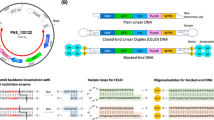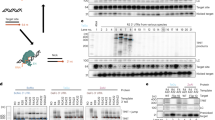Abstract
We have explored a novel strategy for the targeting of retroviral vectors to particular sites or cell types. This strategy involves a method whereby the infectivity of a retroviral vector is neutralized by treatment of viral particles with a photocleavable, biotinylation reagent. These modified viral vectors possess little to no infectivity for target cells. Exposure of these modified viral vectors to long-wavelength UV light induces a reversal of the neutralizing, chemical modification resulting in restoration of infectivity to the viral vector. This infectivity ‘trigger’ possesses great potential, both as a research tool and as a novel tactic for the targeting of gene-transfer agents, since it would become possible to direct both the time and location of a viral infection in a versatile manner.
This is a preview of subscription content, access via your institution
Access options
Subscribe to this journal
Receive 12 print issues and online access
$259.00 per year
only $21.58 per issue
Buy this article
- Purchase on Springer Link
- Instant access to full article PDF
Prices may be subject to local taxes which are calculated during checkout




Similar content being viewed by others
References
Miller AD . Development and applications of retroviral vectors. In: Coffin JM, Hughes SE, Varmus HE (eds) Retroviruses Cold Spring Harbor Laboratory Press: Plainview, NY 1998 pp 438–473
Benedict CA et al. Targeting retroviral vectors to CD34-expressing cells: binding to CD34 does not catalyze virus-cell fusion Hum Gene Ther 1999 10: 545–557
Cosset F et al. Retroviral retargeting by envelopes expressing an N-terminal binding domain J Virol 1995 69: 6314–6322
Somia NV, Zoppe, M, Verma IM . Generation of targeted retroviral vectors by using single-chain variable fragment: an approach to in vivo gene delivery Proc Natl Acad Sci USA 1995 92: 7570–7574
Chu TT, Dornburg R . Toward highly efficient cell type-specific gene transfer with retroviral vectors displaying single-chain antibodies J Virol 1997 71: 720–725
Cosset F et al. High titer retroviral packaging systems which produce human complement-resistant retroviral vectors J Virol 1995 69: 7430–7436
Olejnik J, Sonar S, Krzymanska-Olejnik E, Rothschild KJ . Photocleavable biotin derivatives. A versatile approach for the isolation of biomolecules Proc Natl Acad Sci USA 1995 92: 7590–7594
Wong SS . Chemistry of Protein Conjugation and Cross-linking CRC Press: Boca Raton, FL 1991
Hermanson GT . Bioconjugate Techniques Academic Press, New York 1995
Riggs JL, McAllister RM, Lennette EH . Immunofluorescent studies of RD-114 virus replication in cell culture J Gen Virol 1974 25: 21–29
McKeating JA, McKnight A, Moore JP . Differential loss of envelope glycoprotein gp120 from virions of human immunodeficiency virus type 1 isolates: effects on infectivity and neutralization J Virol 1991 65: 852–860
Schägger H, von Jagow G . Tricine-sodium dodecyl sulfate-polyacrylamide gel electrophoresis for the separation of proteins in the range from 1 to 100 kDa Anal Biochem 1987 166: 368–379
Petropoulos C . Retroviral taxonomy, protein structures, sequences, and genetic maps. In: Coffin JM, Hughes SE, Varmus HE (eds) Retroviruses Cold Spring Harbor Laboratory Press: Plainview, NY 1998 757–805
Swanstrom R et al. Interaction of psoralen derivatives with the RNA genome of rous sarcoma virus Virology 1981 113: 613–622
Hanson CV . Photochemical inactivation of viruses with psoralens: an overview Blood Cells 1992 18: 7–25
Redfield DC, Richman DD, Oxman MN, Kronenberg LH . Psoralen inactivation of influenza and herpes simplex viruses and of virus-infected cells Infect Immun 1981 32: 1216–1226
Schuberth H-J et al. Biotinylation of cell surface MHC molecules: a complimentary tool for the study of MHC class II polymorphism in cattle J Immunol Meth 1996 189: 89–98
Acknowledgements
We thank Kenneth J Rothschild and Jerzy Olejnik for useful discussions and providing photocleavable biotin samples, John C Guatelli and Jonathan Loeb for critical reading of the manuscript, Yasuhiro Takeuchi for the cell line TelCeB6, F-L Cosset for the plasmid pA, R Dornburg for pRD134, and Ruo Jie Wang and Muhammad-Omar Raiss for technical assistance. MWP is supported by a postdoctoral fellowship from the US Department of Army Prostate Cancer Research Program, PC990029.
Author information
Authors and Affiliations
Rights and permissions
About this article
Cite this article
Pandori, M., Sano, T. Photoactivatable retroviral vectors: a strategy for targeted gene delivery. Gene Ther 7, 1999–2006 (2000). https://doi.org/10.1038/sj.gt.3301338
Received:
Accepted:
Published:
Issue Date:
DOI: https://doi.org/10.1038/sj.gt.3301338



